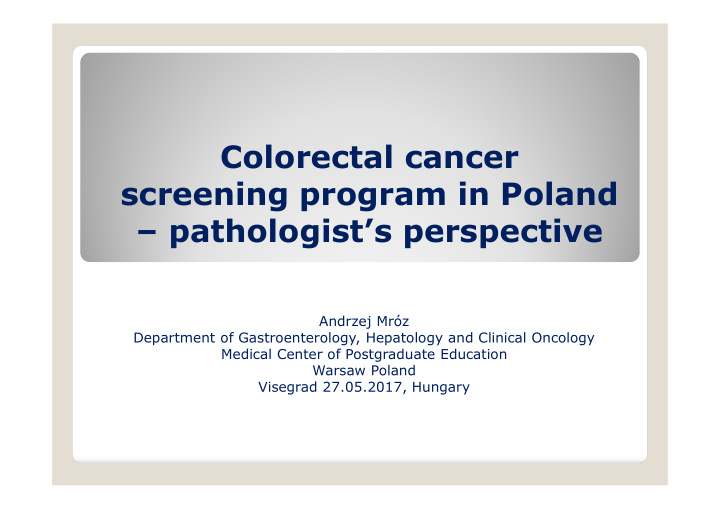



Colorectal cancer screening program in Poland – pathologist’s perspective Andrzej Mróz Department of Gastroenterology, Hepatology and Clinical Oncology Medical Center of Postgraduate Education Warsaw Poland Visegrad 27.05.2017, Hungary
WHO: Screening programs 1. Common disease with high mortality 2. Possible detection of precursor lesions or asymptomatic illness 3. Early detection improves prognosis 4. Socially acceptable 5. Cost effective Wilson JMG, WHO, 1968
Malignant tumors in Poland Lung cancer Colorectal cancer Breast cancer Wojciechowska i wsp. Nowotwory złośliwe w Polsce w 2010 roku, KRN
Dynamics of colorectal cancer incidence Incidence Colorectal cancer Incidence y 90’ 95’ 00’ 05’ Lung cancer y 90’ 95’ 00’ 05’ Males Females
Cancer develops from polyps (adenomas) > > > > > > > > CA >> adenoma Duration: 7 - 12 YEARS
5 year survivals ratios in CRC diagnosis 2000 Europe: 53,5% Poland: 43,7% Berrino F, et al. Lancet Oncol 2007 Krajowy Rejestr Nowotowrów, COI
CRC screening program in Poland � Method: screening colonoscopy opportunistic program till 2011 + invitations based since 2012 � Start: 2000 � Priorities: quality control trainings of doctors/centers optimalization
Why colonoscopy in Poland? • The only one step strategy • Simple organization: once every 10 years • Not expensive: ca.120 euro per/procedure (5 rounds of FOBT) • FOBT acceptance (80-ties) - 16%
Efficacy of population screening programs in RCT � FOBT ◦ CRC mortality reduction: 0,86 (95%CI 0,80-0,92) � Sigmoidoscopy ◦ CRC mortality reduction: 0,72 (95%CI 0,65-0,79) ◦ CRC mortality reduction: 0,77 (95%CI 0,70-0,84) � Colonoscopy ◦ Probably ≥ Sigmoidoscopy Holme O, et al. Cochrane Database Syst Rev, 2013
� Expected results in 2026 ! Kaminski MF, et al. Endoscopy, 2012
Opportunistic program, 2000-11 320 000 screening colonoscopies 92 centers in 2011
Invitations based screening program
High Quality Histopathology � Unification of reports � Pathologic report in categorization � Linked to central database (as a incoherent part) � Trainings � Adenoma detection rate – checked by pathologists as endoscopist and screening quality indicator
Histopathological report � Histological type � Architecture � Grade of dysplasia Adenoma � Completeness of resection
Reporting challenges � Grade of dysplasia – some of pathologists are used to three tier classification � No proforma required � Completeness of excision reporting – restrictive way, limited contact with the clinician
Completeness of excision
HGD in adenomas EGuide � 7.21- Pathologists reporting in a colonoscopy screening programme should not report high-grade neoplasia in more than 5% of lesions and those in an FOBT programme in not more than 10% of lesions � HGD – up to 5%
Reporting of polyps – by center
Reporting of polyps – by pathologist
Reporting of polyps – by pathologist
Reporting of polyps – by pathologist
Serrated polyps 2000-2004 � Morphological analysis and predilection factors of colonic serrated polyps in participants of colon cancer screening programme in years 2000-2004.
Serrated polyps 2000-2004 2970 SP � 1819 MVHP � 816 GCHP � 249MPHP � 58 SSP � 28 TSA
MVHP GCHP MPHP SSP TSA All 58,25% 31,38% 9,62% 0,30% 0,44% 1351 Rectum 62,74% 28,15% 7,27% 1,13% 0,72% 977 Sigmoid colon 62,32% 26,81% 5,80% 2,17% 2,90% 138 Descending colon 66,83% 17,07% 7,32% 6,83% 1,95% 205 Transverse colon 66,99% 15,53% 7,28% 8,25% 1,94% 206 Ascending colon 62,37% 13,98% 10,75% 9,68% 3,23% 93 Cecum 1819 816 249 58 28 2970 All (61,25%) (27,24%) (8,38%) (1,95%) (0,94%) (100%)
MVHP GCHP MPHP SSP TSA All 43,27% 51,96% 52,21% 6,90% 21,43% 45,49% Rectum 33,70% 33,70% 28,51% 18,97% 25,00% 32,90% Sigmoid colon 4,73% 4,53% 3,21% 5,17% 14,29% 4,65% Descending colon Transverse 7,53% 4,29% 6,02% 24,14% 14,29% 6,90% colon Ascending 7,59% 3,92% 6,02% 29,31% 14,29% 6,94% colon 3,19% 1,59% 4,02% 15,52% 10,71% 3,13% Cecum All 1819 816 249 58 28 2970 (100%) (100%) (100%) (100%) (100%) (100%)
Serrated polyps 2009-2012
Serrated polyps 2009-2012
Serrated polyps � Incidence is variable (2,2-4,8%) � Criteria applied � Not restricted to right bowel
Trainings for pathologists � Initial training – at the entrance point � Ad hoc trainings – upon results of analysis (HGD, villous component, completeness of excision ) � Serrated polyps – unconventional!!! - international cooperation?
Why is it crucial?
Cumulated risk of interval cancer according to ADR
Most advanced lesion and categorization; incorportation of histopathological diagnosis in central database
Most advanced lesion and categorization; incorportation of histopathological diagnosis in central database
Summary � High quality pathology is a must � Shortage of pathologists � Regular trainings � Cooperation � Most advanced lesion and centralized histology
Recommend
More recommend